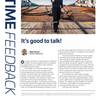Training Tips for Ships: Embracing Technology
Tip #49 - Embracing Technology for Effective Maritime Training
The maritime industry, like so many others, has experienced a wave of technical advances in recent years. These changes have opened new doors for enhancing the quality of training and skill development for maritime professionals. In this edition of Training Tips for Ships, we'll consider how incredibly far we have come and explore how embracing technology can lead to more effective and efficient maritime training.
Digital technologies have been making their way into maritime training, especially over the last two decades. And in that time, they have truly transformed our training approaches and effectiveness. Consider the tools we have now, many of which did not exist 20 years ago; E-learning, simulators, virtual reality (VR), and augmented reality (AR) are just a few examples of the tools that have gained popularity in recent years.
These innovations have provided new opportunities for both trainers and trainees to access resources, collaborate, and learn more efficiently.
The adoption of these technologies in maritime training offers increased flexibility and accessibility for both trainers and trainees. E-learning platforms allow trainees to access educational materials anytime and from anywhere (onboard or on shore), making it easier for them to fit learning into their busy schedules. Additionally, trainers can update and distribute content more easily, ensuring that trainees always have access to the most up-to-date information, even when in poorly connected maritime environments.
Digital tools such as simulators, VR, and AR can create immersive learning experiences that are more engaging than traditional classroom methods. These technologies enable trainees to practice skills in realistic scenarios, and to experience situations that are rare and/or dangerous in reality. By providing a more realistic and interactive learning environment, these tools can help to improve learner motivation and interest, which in turn improves learning outcomes.
In addition, digital platforms offer a wealth of data and analytics capabilities that can be used to track trainee performance and provide feedback. Trainers can use this information to identify competency areas where trainees may be struggling and tailor their teaching methods and learning plans accordingly. This data-driven approach can lead to more personalized and effective training programs.
And despite the fact that implementing these technologies in maritime training may require an initial investment, they can lead to significant cost savings in the long run. E-learning platforms and digital resources can reduce the need for physical materials, travel, and facility rental expenses. Additionally, digital tools can help to streamline administrative tasks and reduce the time required for trainers to prepare and deliver training materials.
Having said all this, it is important to recognize that implementing these technologies can present challenges. Some common obstacles include resistance to change, lack of technical expertise, and concerns about the effectiveness of digital training methods vs. traditional means. To overcome these challenges, it is useful to adopt a strategic approach to digital learning transformation. There are many suggestions to consider.
First, before implementing digital technologies, it is useful to establish a clear vision for how they will be used to enhance training and outcomes. This plan should outline the specific tools and resources that will be utilized, as well as the goals and objectives that the organization hopes to achieve through digital transformation.
As with any new initiative, it is important to monitor the progress of digital transformation efforts and make adjustments as needed. This can involve gathering feedback from trainers and trainees, tracking performance metrics, and staying informed about emerging technologies and best practices in maritime training.
Technology holds immense potential for improving the effectiveness and efficiency of maritime training. By embracing these innovations, organizations can provide more flexible, engaging, and data-driven learning experiences for their trainees. However, it is essential to approach the implementation of digital technologies strategically, addressing challenges and ensuring that trainers and trainees have the support they need to succeed. By doing so, the maritime industry can continue to advance and equip its workforce with the skills necessary to thrive in an increasingly complex and dynamic environment.
Thanks so much for reading and until the next edition of Training Tips for Ships, sail safely.















